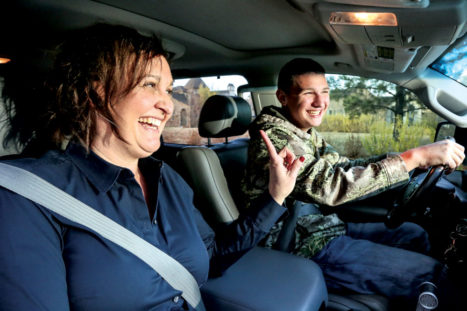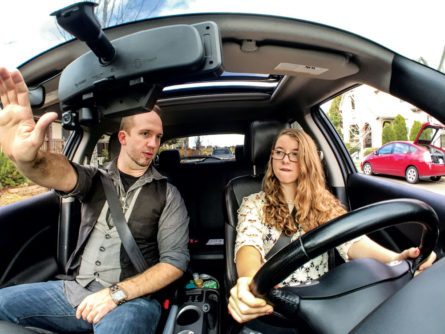
Maggie Roesink prepares to take her mother, Birgit Roesink-Miller, for a ride.
While DPS has been scrambling to find seats for the many children who started arriving in Stapleton over 10 years ago, residents have been wondering what the streets will be like when those babies are teenage drivers.
Drivers Ed from Anne Hebert on Vimeo.
Now the “baby bubble” is reaching the age for learner’s permits—and parents may be finding things have changed since they learned to drive. “Getting a teen ready to drive is a bit more complicated than many parents believe,” says Ryan Badger, owner of Badger Driving School LLC. “Road laws change over time. If you learned to drive 20 years ago, your knowledge gap may be much wider than you thought.” He also points out that driver training with an objective instructor can be less stressful for the student and the parents than teaching your own child to drive.
Teens who are accustomed to using their passenger time to communicate with friends on their cellphones are discovering it’s another world when they are the driver. “The experience of riding as a passenger is different than actually driving,” says Jonah Landeck, age 15. “It’s much harder to navigate and be constantly aware than I thought.”

Jonah Landeck and his mother Nicole Landeck find some humor in behind-the-wheel practice.
“Behavior programming is important,” says Badger. “I recommend that students put their cell phone in driving mode and put it in the glove box or side console to avoid cognitive distraction. While there are several apps that disable a phone while a car is running—and these can often be helpful—I find it’s better to train students to avoid having their phone easily accessible from the start.”
Statistics from the U.S. Department of Transportation show that the use of cell phones while driving plays a role in 1.6 million auto accidents each year, causing 500,000 injuries and 6,000 deaths. Text messaging while driving is banned in 46 states, including Colorado, and the District of Columbia. Statistics show that people who text while driving are 23 percent more likely to be in an accident as compared to other drivers. Accident rates, which declined for years, are on the increase. Many experts believe distracted driving is contributing to that increase.
The cellphone may be safely tucked in the glove box, but it can be at work creating the log new drivers submit when getting their license. Landeck says he uses an app with GPS that tracks his miles, speed, road conditions and the weather. He will export this information into a spreadsheet for the Department of Motor Vehicles when he takes his driving test.
Fifteen-year-old Maggie Roesink, who has four hours of online classroom drivers training under her belt so far, is discovering that parallel parking and highway driving are among the early challenges that she’s nervous about. Landeck concurs, saying he’ll be driving on city roads to achieve a comfort level before doing much highway driving.
Most parents suffer some anxiety about having new teen drivers behind the wheel. To ease some of that anxiety, Landeck and his parents already have an agreement that permits him to use their Uber account if he finds himself in an uncomfortable situation once he has his license.

Ryan Badger, owner of Badger Driving School LLC, instructs 15-year-old student Carolyn Elsner. Badger uses a car equipped with a brake on his side if needed for safety when he is out instructing new drivers.
On a more positive note, parents gain the benefit of another driver in the family. Both Landeck and Roesink will be expected to help transport younger siblings to their activities. Landeck thinks it will also be a ticket to employment opportunities that will cover expenses of having his own car. Meanwhile, he’ll find a job he can walk or bike to.
With self-driving cars being predicted by some auto manufacturers as early as 2019, learning to drive may not be relevant for future teen drivers. Landeck agrees, adding, “I’m kind of a sci-fi nut. It would be really cool to have driverless cars—but in the meantime, it seems like a solid skill to learn.”
Colorado New Driver Rules
In Colorado, teens must hold a driver’s permit for one year and complete 50 hours of driving to be eligible to take the driver’s test. Ten of those hours must be done at night and a minimum of six hours must be completed with a certified driving instructor in the vehicle.
Drivers under age 18 may not drive with friends in the car unless there is an extenuating circumstance allowed by the law. Immediate family may ride with a driver under 18 as well as drivers over the age of 21 who have had a valid driver’s license for more than one year.
Many auto insurers offer a discount for teens who have completed training. Some schools offer specialized skills training, giving new drivers a chance to practice what to do when they encounter icy roadways or an animal leaping in front of their car, minimizing the likelihood of incorrect reactions to such circumstances.
Correction:
New Driver Rules are not listed in their entirety. For complete information, please visit www.colorado.gov/pacific/dmv/minor-license.




Hello Ms. hebert,
I thank you for this article but wanted to provide some critical corrections. Your article ended with a broadbrush statement about New Driver Rules. You only mentioned the rule for driver restrictions between the hours of 12am-5:00 am. Otherwise, Colorado has progressive teen driver requirements which allow teens to drive with non-siblings under 21 years starting 6 months after they have had their license. Once they have held their license for a year, they may drive with as many passengers under 21 as there are seatbelts. Here is the website with details you might want to provide as a correction in your next edition: https://www.colorado.gov/pacific/dmv/minor-license.
Dear Ms. Oss,
Thank you for the additional information. I will provide clarification with a correction to the story in the January issue.